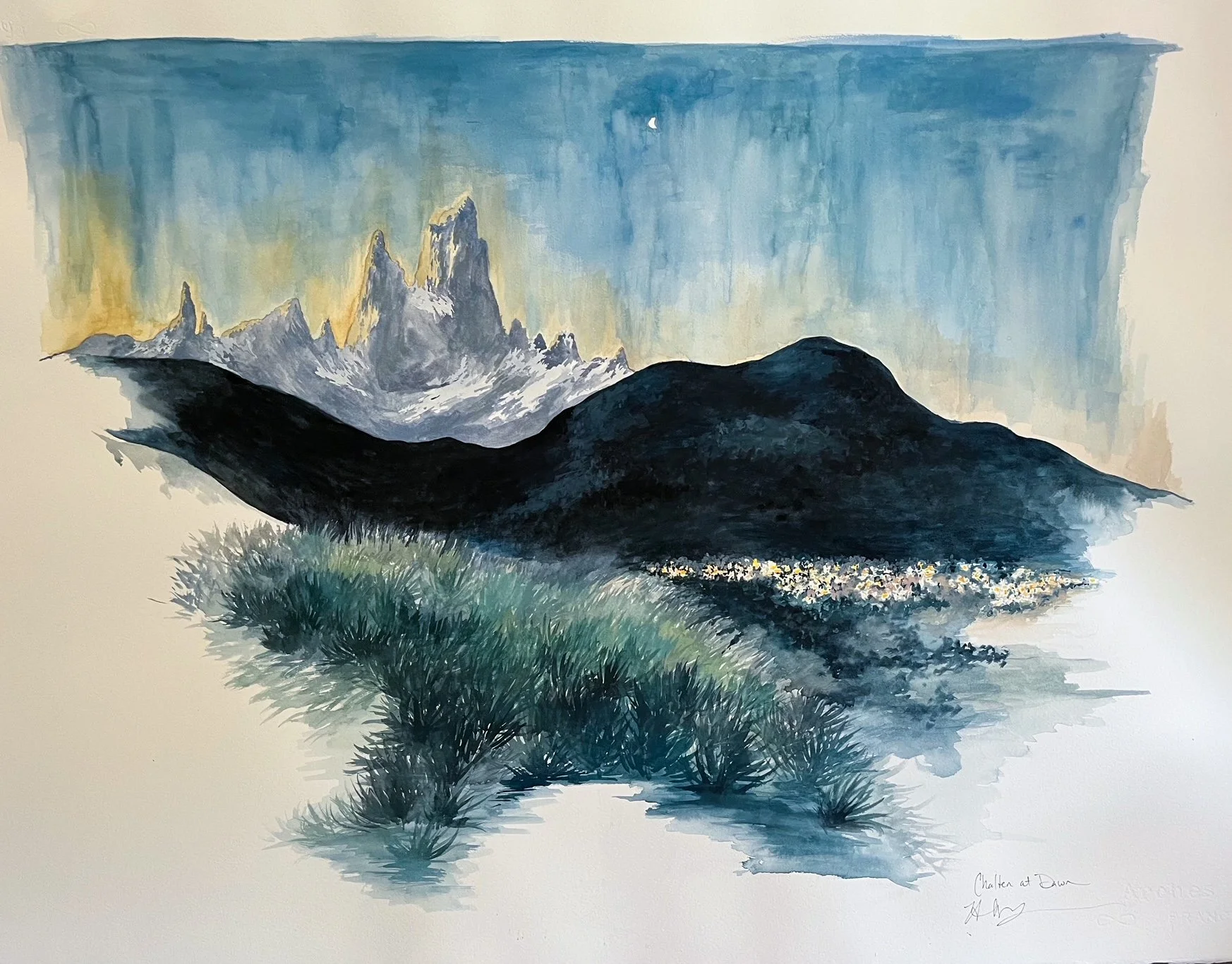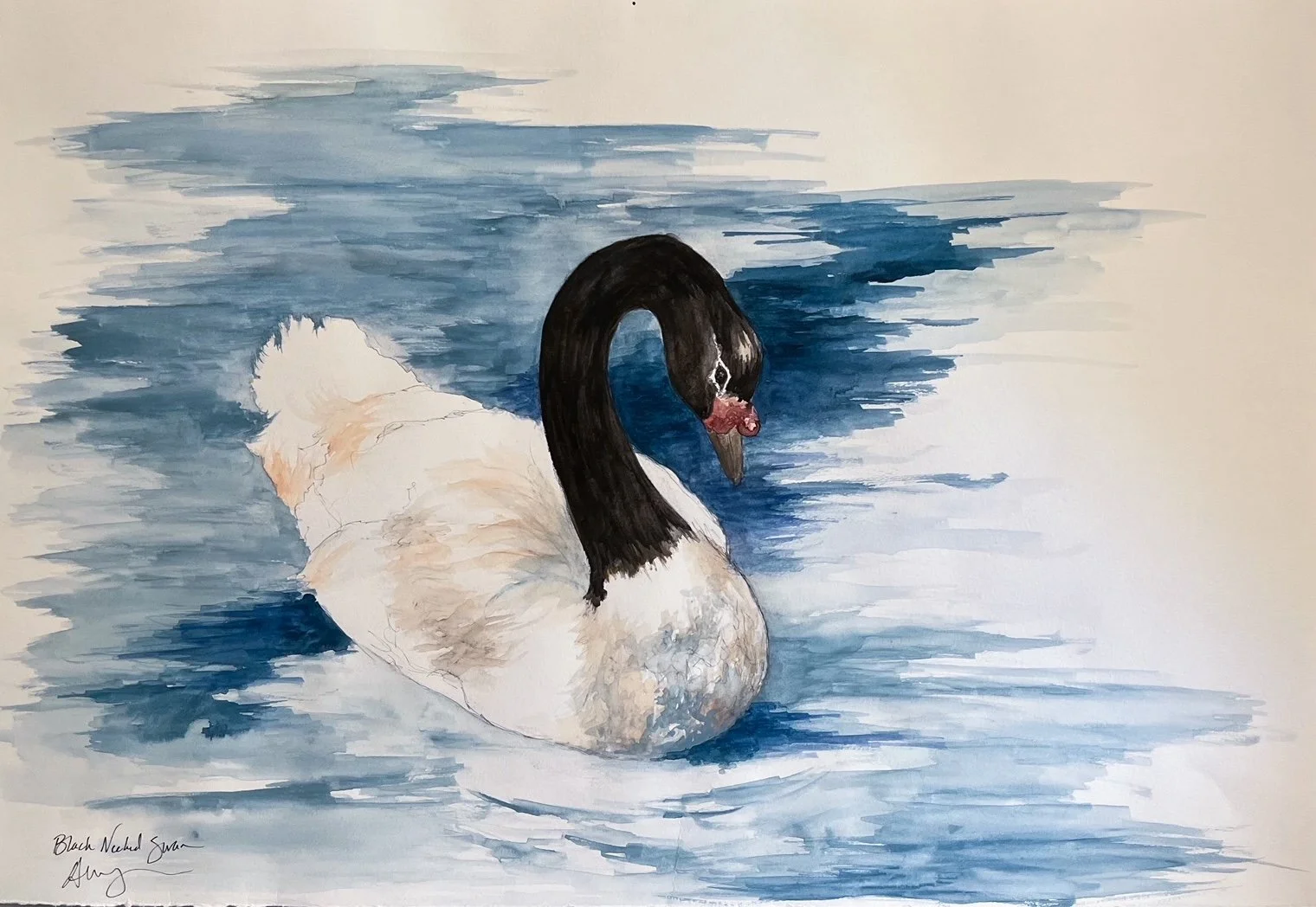Ode to Patagonia
A few years ago, my husband and I had the opportunity to travel to South America and explore the Patagonian Region of Argentina and Chile. It is an extraordinary place full of beautifully bizarre landscapes, and plants and animals that are equally strange and interesting. I decided to paint a collection of the landscapes, flora & fauna of this region. This current collection of original work is up at Jola Cafe in Portland, Oregon for the months of August and September 2024. All pieces are watercolor on paper. Prints are available upon request.
“Chalten at Dawn”
The town of El Chalten sits at the base of Mount Fitzroy, the most famous of the Patagonian Peaks. It’s tucked deep into a valley surrounded by these incredible mountains. From the town we hiked to the base of these peaks, walking through the Magellanic forests and glacier fed streams to sit at the feet of these peaks at a little lake with icebergs floating in it.
“Desert Lake”
One of the most striking aspects of this landscape is the high plateau deserts flowing into the mountains. Even more so are the flamingos that gather and graze in these arid lakes. I found the scene strikingly beautiful and wanted to capture the strangeness of it all together.
“Chilean Flamingos”
These beautiful birds gather in the high plateau and desert lakes of Patagonia. It’s surreal to see them in such a harsh and arid landscape. We were able to see them a few times in what looked like the middle of nowhere.
“Black Faced Ibis”
These funny, yet elegant looking birds are found in the grasslands and high plateaus of the Patagonian Region. They are medium sized, about the size of a green heron, and are very boisterous. We saw a few, nesting in treetops in the town of El Calafate. They made a huge racket, were extremely gawky and were very funny to watch.
“Black Necked Swan”
Among the many waterways that sit at the bases of most of the Patagonian mountains, these beautiful black necked swans live. When we were there, the water was white capped with high winds and was strikingly cold. Yet these swans were raising their young, these tiny grey fluffs were gathered around a few adults as they swam through these harsh waters. I love how graceful and elegant these birds are contrasted with the dark waves of their landscape.
“Grey Fox”
Another mammal we were able to see while there was the Chilean grey fox. They are fairly small and live in the grasslands and steppe of the Patagonian mountains. We were able to watch one for about an hour at the border crossing from Argentina to Chile as one was hunting mice and watching the tourists arrive just off the road. He didn’t seem fussed by the amount of people and after catching a mouse, ate it, and then sat down to watch and relax.
“Calafate Blossoms”
What better way to see a berry than to also see its blossom. Especially when the blossoms are so lovely and yellow. When we were there, we were fortunate to have most of the berries already bloomed and ready to eat, but a very few left in the higher elevation parts still had these beautiful little blossoms on them.
“Upland Goose”
These small geese gather and feed in the grasslands of the Patagonain Steppe. We only saw a few clusters of them, but they are beautifully colored and are one of the few bird species found this far south.
“The Torres”
One of the most beautiful mountains in all of Patagonia, this collection of peaks is best viewed from across the water of Lago Pehoe. We climbed around the base of these mountains during a several day trek, but didn’t get to see how stunning these mountains are until we were on a boat leaving. The landscape is extremely windy and harsh, there are glaciers set into the slopes of these peaks. Andean condors fly above and tiny orchids speckle the ground.
“Darwin’s Lesser Rhea”
This landscape has very few animals, but those it has seem not to fit into this place. These large, ostrich (or emu) like birds roam the grasslands and high plateaus of the Patagonian Steppe. They are closer to the size of an emu and can be spotted grazing in the grasses out in the open of the plains.
“Valle Ascencio”
These three peaks can only be seen by foot after hiking deep into the Patagonian Mountains. We hiked half the day to reach our camp for the night, and up, up, up into the mountains. It was another steep few hour hike from camp to reach this tiny valley and lake. It’s covered in clouds most of the time but when you’re lucky, the clouds clear, and you can see them.
“Moreno Glacier”
An absolute must see in this region of Argentina. Located just an hour from the desert and high plateaus, you drive into the low mountain range and the mountains break open to view this immense glacier marching into the water. This painting is just a small section of this massive river of ice. It is truly only an impression of it, but the colors are accurate with the mixture of intense teal blue of the ice, the minerally pale blue of the water and the dark rocks of the earth below and above.
“Calafate Berries”
By far the most popular plant in all of Patagonia. It’s made famous by creating a liqueur with it and then adding it to a Pisco Sour, called a “Calafate Sour”. The berry, and thus juice, is tart and thick. It is very similar in taste to a black currant. When trekking or going out to eat in this area, these drinks are the most popular cocktails served at the bar (and are really good). The plants grow along the Patagonian steppe and while hiking we definitely foraged and ate them whenever we could.














